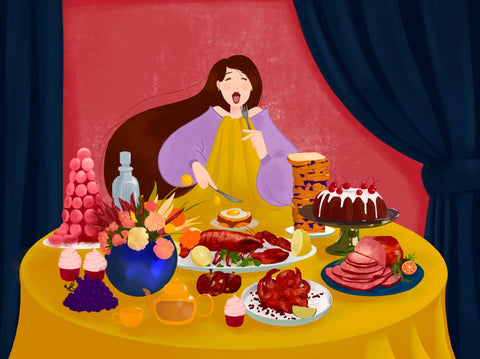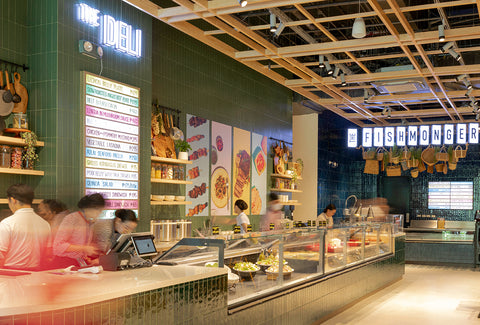Love is complex, encompassing a wide range of emotions, experiences, and expressions that differ from one person to another. As such, expressing and receiving love can mean different things to everyone; we all have different “love languages”—a term first coined by American author Gary Chapman in his book “The 5 Love Languages: The Secret to Love That Lasts.” According to him, there are five primary love languages: words of affirmation, acts of service, receiving or giving gifts, quality time, and physical touch.
When we think about how we express love, food can often come into the picture, seamlessly weaving itself into the already established love languages. Food, after all, can take on many roles and meanings in our lives. From its selection, preparation, and presentation, to the shared experience of savoring a meal together, food arguably encompasses all five.
Kumain ka na ba?
Food is a universal language everyone understands, regardless of their background, culture, or ethnicity. At Filipino tables, “Tara, kain tayo!” is an invitation to come and enjoy food together—a common practice we also follow in another food tradition called salu-salo where food is meant to be shared. “Kumain ka na?,” a simple statement offering or inviting you to eat, is love wrapped in three words—sometimes carrying as much weight as the words ‘I love you.’ It’s the same sentiment behind a simple “I got you coffee,” from a friend which, at the heart of it, is a thoughtful gesture. “I saved you a seat” in crowded gatherings and reunions tell us that we are remembered, while “you can have the last bite," may seem small yet can be a significant gesture of sacrifice, showing a willingness to share.
As speaker and author Alan D. Wolfelt said: “Food is symbolic of love when words are inadequate.” It is our way of saying we care and love those around us; even with a tiny nod or a soft murmur of “hmmmmmm” means we appreciate and enjoy the food and the efforts put into making it.
Sundays with dad
Food is an expression of love, a way to connect with your loved ones. It is, for example, how my parents have always shown me love: they make sure I have something to eat every morning, and even prepare some baon that I can take to school, and now to work. It is a heartfelt message of encouragement, an act of service in the kitchen that goes beyond words.
My personal journey with food as an act of service began on ordinary Sundays, along with the clinking of pots and pans, in the bustling kitchen of my childhood home. The aroma of simmering spices and the tender embrace of baking bread encapsulated more than just a meal; it was an embodiment of my father’s love.
My father, a maestro in his kitchen, didn’t merely cook; he orchestrated symphonies of flavors that resonated and stayed with those he fed. From the ritualistic process of selecting the freshest produce to the meticulous act of layering flavors, each meal he prepared was an act of devotion, a testament of his enduring love for us.
Something to share
Owing to my father’s love for cooking, the kitchen became my family’s sanctuary—it’s the place where stories were exchanged, laughter echoed through the walls, and love was served generously on every plate.
Whether it's a family gathering, a romantic dinner, or a casual get-together among friends, the act of sharing a meal fosters connections and creates moments of intimacy and joy. I remember the joyous chaos of family reunions, the meaningful reconnections with old friends, and the excitement of getting to know someone new.

The same goes for potlucks, where friends bring pieces of themselves to share—each dish being a personal contribution. In this communal act of giving and receiving, love is spoken through the diverse array of flavors and textures that grace the table. Regardless of our differences, we can almost always find something in common with someone we eat with.
Thoughtful gestures
They do say the way to a person's heart is through their stomach, and nowhere is this more evident than in the simple act of preparing and offering our favorite dishes to guests, or our hosts sending us off with containers of leftovers to make sure we have something to eat tomorrow.
Whether it’s buying a friend her favorite chocolate when she’s feeling sad or a new snack you’re guessing she might enjoy, it all says the same thing: I thought of you. Because beyond the food itself, it’s the sentiment that matters—the time taken to select the perfect treat, the thought put into its presentation, and the joy in seeing the recipient's face light up with delight.
Similarly, the act of baking a cake for someone's birthday or preparing a comforting soup for a sick loved one conveys care and empathy through nourishment. In these small but meaningful gestures, love is expressed in its purest form.
Going through the motions
Food, in its essence, is also an art form—a canvas where creativity meets culinary skill. The fusion of flavors, textures, and presentation isn’t just about feeding the body but also about nurturing the senses.
In the language of love, physical touch is a powerful means of communication, conveying warmth and affection. In the same manner, it’s within the tactile actions and mindful focus of cooking and preparing food—the meticulous plating of a gourmet dish, the stirring of a pot, or the constant kneading of a dough— that one is able to convey their love and affection.
Food’s ability to embody all five love languages provides unique and timeless ways to express one’s care. From a simple question of “kumain ka na ba?” to sending takeout to an overwhelmed loved one to the time and effort spent in cooking, food stands as an enduring testament to love's universality.
As the saying goes, "Food is love made edible"—and what greater gift could there be than that?





